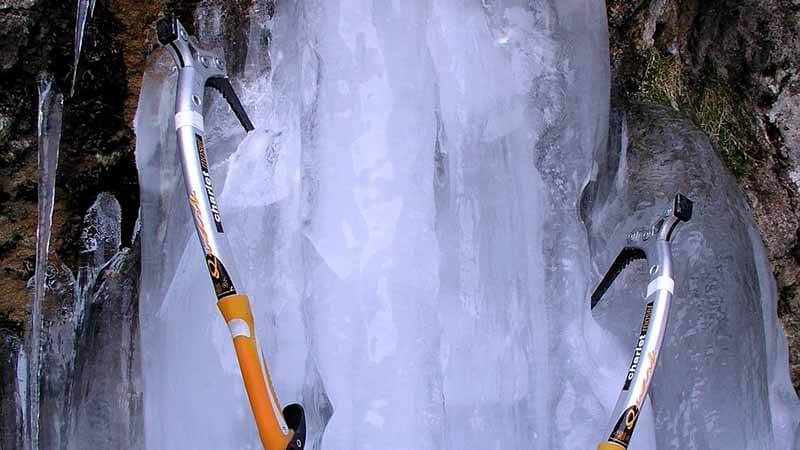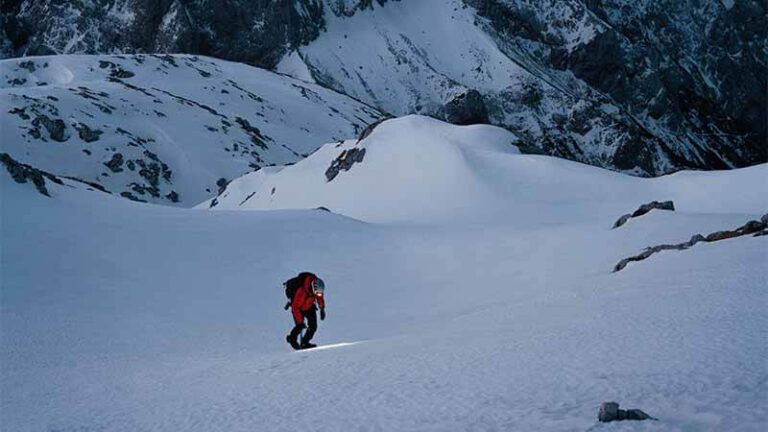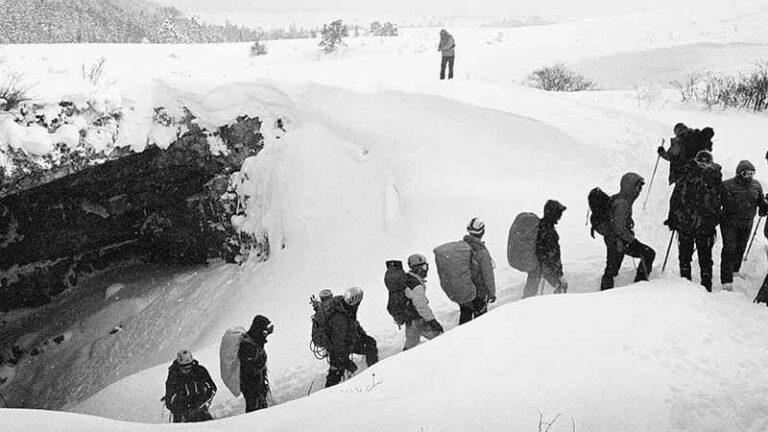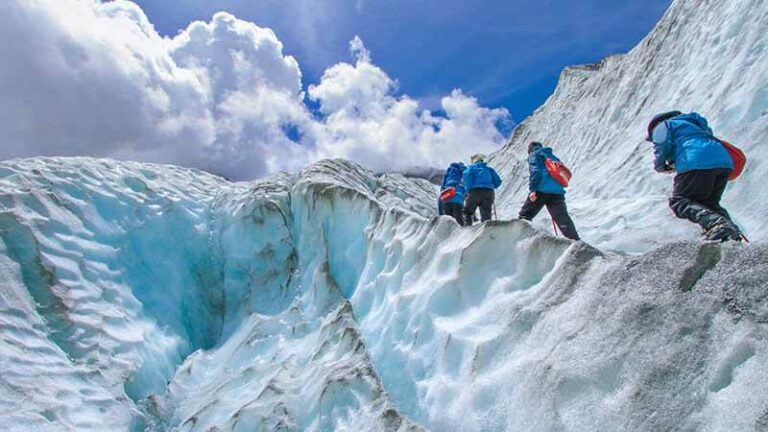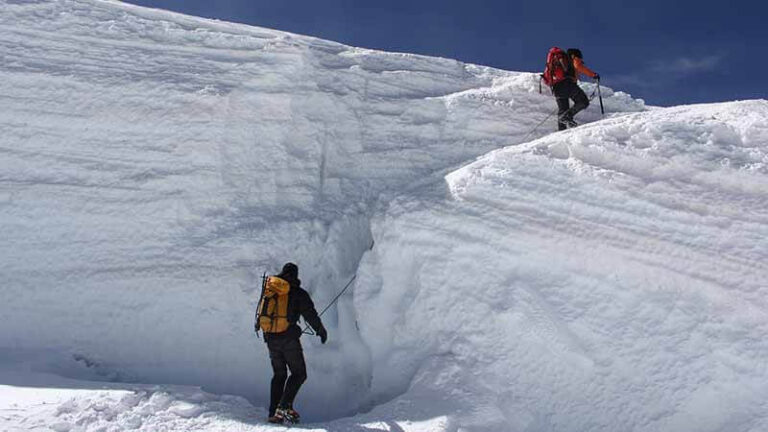Types of Ice Climbing Axes: A Detailed Comparison
Ice climbing is a thrilling and hard sport that needs climbers to handle some of the harshest and most unforgiving situations on the planet. The choice of ice climbing axe is one of the essential aspects that can make or break a climber’s success and safety.
The ice climbing axe is a direct extension of the climber’s body that allows them to secure their grasp on the ice, mount vertical cliffs, and defend themselves in the event of a fall. Choosing the correct ice climbing axe is critical since it has a direct impact on a climber’s performance, safety, and overall ice experience.
An unsuitable axe might result in decreased control, increased fatigue, and potentially unsafe situations. As a result, recognizing the subtleties of various ice climbing axe types is critical for climbers of all levels.
What are the different types of Ice climbing axes?
There are three main varieties of ice climbing axes in the world: technical ice axes, mountaineering axes, and ice tool hybrids. Each of these categories is distinguished by its own design, features, and intended use cases.
Technical ice axes are specialist equipment designed for use on steep ice and varied terrain, providing precision and control in difficult situations.
Mountaineering axes, on the other hand, are adaptable, lightweight tools that may be used in a variety of mountain and glacier trip conditions. Ice tool hybrids offer a balanced blend of performance and versatility, bridging the gap between these two extremes.
Climbers can obtain a full awareness of the options accessible to them by studying these three basic types of ice climbing axes, allowing them to make informed judgments based on their unique climbing goals and the situations they want to confront.
Technical Ice Axes
Technical ice axes are specialist instruments intended for ice climbing and mixed terrain. They are precision devices designed to provide climbers the most control and stability on steep, icy terrain.
The primary function of these axes is to allow climbers to penetrate hard ice and give strong placements for protection and advancement while ascending difficult routes.
Design and features
Shaft length and material
Shorter shafts built of lightweight yet robust materials such as aluminum or carbon fiber are typical of technical ice axes. The shorter length enables precise control and efficient swing placement, which is essential for steep ice climbing.
Pick design and angle
Picks on technical ice axes are designed specifically for ice, with a curved shape that helps them to bite securely into the ice. They frequently have strong serrations for increased grip. The pick’s angle is tailored for optimal penetration of hard ice.
Adze and hammer options
Some sophisticated ice axes include extra elements such as adzes or hammers on the back side of the pick. These can be used to clear ice, cut steps, or place pitons in varied terrain.
Advantages of technical ice axes
Precision and control
Climbers who use technical ice axes have more exact control over their placements. This accuracy is critical for crossing steep ice or mixed terrain, when every swing counts.
Versatility in steep ice and mixed terrain
Technical ice axes are built to withstand the most difficult ice climbing situations. They perform very well on vertical ice walls and mixed routes, providing climbers with the security and stability they require in difficult circumstances.
Disadvantages of technical ice axes
Limited performance on less steep terrain
While technical ice axes are excellent for steep ice and mixed routes, they may not be the best choice for less difficult terrain like as moderate alpine climbs or glacier trips. In such cases, its specific design may feel clunky and superfluous.
Specialized use may not suit all climbers
Technical ice axes are designed specifically for ice climbing. Climbers who participate in a variety of mountaineering activities may find that investing in a more adaptable ice axe that can handle a wider range of situations is more practical. Specialized technical ice axes may also necessitate a longer learning curve for inexperienced climbers, making them unsuitable for novices.
Mountaineering Axes
Climbers that engage in a variety of alpine activities, such as glacier travel, snow-covered terrain, and less difficult climbs, require mountaineering axes.
Their major function is to give stability, balance, and support while traversing mountainous terrain.
Mountaineering axes, as opposed to technical ice axes, are intended for usage other than steep ice and mixed terrain.
Design and features
Shaft length and material
Mountaineering axes have longer shafts than technical ice axes, allowing for more reach and stability on uneven terrain. To create a balance between strength and weight, these shafts are frequently composed of materials such as aluminum or lightweight steel.
Pick design and angle
Mountaineering axe picks are flatter and less aggressive in design than technical ice axe picks. This makes it easier to penetrate snow and softer ice. The pick’s angle is tuned for self-arrest in the event of a slip or fall.
Adze and hammer options
Many mountaineering axes have adzes and hammers on the other side of the pick. These features are useful for clearing snow, chopping steps, and making snow or ice anchors.
Advantages of mountaineering axes
General-purpose functionality
Mountaineering axes are adaptable instruments that can be used for a variety of alpine activities, from glacier travel to non-technical ascents. When walking on snow-covered slopes or crossing crevasses, they give stability and support.
Lightweight and compact
Mountaineering axes are often smaller and lighter than technical ice axes. This makes them convenient to carry on lengthy approaches and less difficult climbs where the added weight of a technical ice axe may be unneeded.
Disadvantages of mountaineering axes
Limited performance on steep ice and mixed terrain
Mountaineering axes are superb for their intended use, but they are not intended for the technical demands of steep ice climbing or mixed routes. Attempting such climbs with a mountaineering axe might be difficult and dangerous.
Reduced precision and control
When compared to technical ice axes, mountaineering axes provide less accurate control. Climbers can not expect the same level of precision and grip on steep ice or mixed terrain because their design is geared for self-arrest and basic ice and snow tactics.
Ice Tool Hybrids
As the name suggests, ice tool hybrids are a flexible type of ice climbing equipment that include aspects of both technical ice axes and mountaineering axes. These hybrid tools are intended to provide climbers with a balanced solution that can adapt to different climbing situations and terrains, making them perfect for individuals who do both ice and alpine climbing.
Design and features
Combining elements of technical ice axes and mountaineering axes
Ice tool hybrids have a design that combines the precision of specialist ice axes with the adaptability of mountaineering axes. They frequently have a shorter shaft than regular mountaineering axes and a more curved pick than standard ice tools.
Adjustable options
Many ice tool hybrids include customizable features like replaceable picks and grips, allowing climbers to customize the tool’s configuration to the unique climbing condition. Because of their versatility, they are a viable option for a wide range of situations.
Advantages of ice tool hybrids
Versatile for a range of climbing conditions
The versatility of ice tool hybrids is their key advantage. They excel on steep ice and diverse terrain, offering a strong balance of precision and control. Because of their adaptable design, they are appropriate for general climbing, glacier travel, and less demanding ascents.
Balanced performance
Ice tool hybrids are designed to strike a balance between the specialist capabilities of technical ice axes and the general-purpose functionality of mountaineering axes. This balance enables climbers to accomplish a wide range of climbing objectives without switching between numerous equipment.
Disadvantages of ice tool hybrids
May not excel in specialized scenarios
While ice tool hybrids are useful for a variety of tasks, they may not outperform specialized tools in their respective fields.
Climbers may find that dedicated technical ice axes provide superior performance and control on exceptionally steep ice or difficult mixed routes.
Slightly heavier than specialized axes
Because of its versatility and the additional qualities that allow it, ice tool hybrids may be slightly heavier than dedicated technical ice axes or mountaineering axes. This added weight may be a consideration for climbers who want to minimize weight for lengthy approaches or alpine climbs.
Choosing the Right Axe for Your Needs
Consideration of personal climbing objectives
One of the first and most important elements to consider when choosing an ice climbing axe is your personal climbing ambitions. Consider the types of climbs you want to do, such as technical ice routes, mountaineering trips, mixed terrain, or a mixture of these. Your climbing axe should be appropriate for your objectives and the level of technicality you expect to encounter.
Analyzing the specific terrain and conditions you’ll encounter
The terrain and environmental conditions you expect to encounter are important factors in axe choosing. Technical ice axes may be required for precision and control when climbing steep ice. Mountaineering axes or ice tool hybrids may be ideal for alpine climbs, glacier trips, or less demanding ascents because to their versatility in different terrains.
Balancing weight, versatility, and performance
It is vital to strike the proper balance between weight, adaptability, and performance. Consider the length and materials of the axe shaft, the pick design, and any other features such as adzes or hammers.
A lighter axe is useful for long approaches, yet a more adaptable instrument may help you tackle a wider variety of climbs. However, keep in mind that specialist tools work better in their own domains.
Budget considerations
Another important consideration when selecting an ice climbing axe is your budget. Because of their precision manufacturing, specialized technical ice axes might be more expensive, but mountaineering axes and ice tool hybrids are generally more affordable.
It is critical to balance your budget with your climbing requirements. Remember that quality and dependability should never be sacrificed for cost reductions, especially when safety is involved. To ensure both safety and performance while climbing, it may be essential to invest in the best axe that fits within your budget.
Conclusion
In the realm of ice climbing, selecting the appropriate axe is more than simply a personal preference; it is a decision that has a direct impact on your safety, performance, and overall pleasure of the sport.
We’ve looked at the three main types of ice climbing axes: technical ice axes, mountaineering axes, and ice tool hybrids, each with its own set of benefits and drawbacks.
As an ice climber, your choice should be based on your climbing goals, the terrain you’ll be climbing on, and the weight, adaptability, and performance balance you seek. Technical ice axes provide precision and control for individuals who prefer steep ice and mixed terrain.
Mountaineering axes are useful for a wider range of alpine activities due to their versatility and ease of usage. Hybrid ice tools establish a balance by adjusting to a variety of situations and terrains.
Finally, the best ice climbing axe for you is determined by your own needs and tastes. It’s important to note that experimenting with different axes and obtaining guidance from experienced climbers can help you find the best fit for your climbing style and goals.
Remember that safety is of the utmost importance when ice climbing. Whatever sort of axe you choose, be sure it is well-maintained and appropriate for the conditions. Invest in high-quality equipment and, most importantly, keep honing your talents through training and experience.
You can start on great ice climbing excursions with confidence and joy if you have the correct axe and perfect technique. Have fun climbing!

